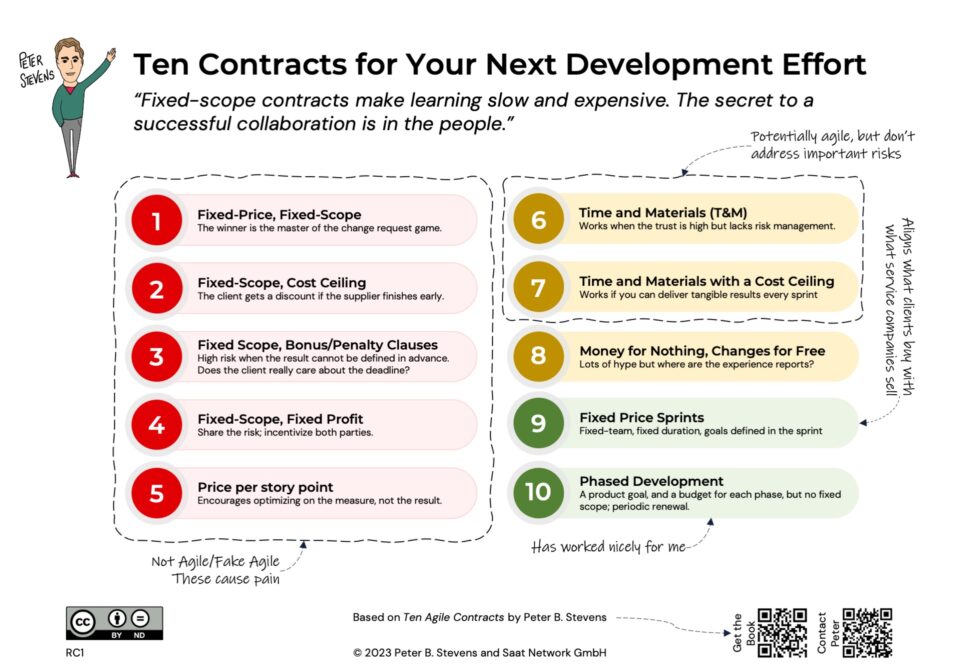
Deep-Dive into the Agile Contract Manifesto (Part 3/4)
30-03-2022
The elephant in the Agile living room
15-06-2022The Agile Contract Manifesto is a guideline for establishing agile partnerships. It is a simple collection of values and principles that help people and organizations meet their needs for flexibility and responsiveness in the context of a written contract. Why did we choose the values and principles that we did. What do the values and principles really mean? Karsten Eskelund, Mirko Kleiner and I hosted a deep-dive webinar on the Agile Contract Manifesto to explain the thinking of the ACM creators.
This post covers the principles six to ten:
- Impediments can arise anywhere in a collaboration. A successful result depends on a smooth communication and information flow across boundaries to rapidly identify and respond to issues.
- Embed mechanisms to manage risk rather than merely allocate risk. Manage risk through transparency, frequent delivery and fast feedback.
- Ensure clarity on needs and available capabilities. Contract for what is really needed and understand what is really being sold.
- Continuity and sustainability are essential for long-lived solutions. The team which creates a new solution develops unique knowledge about the product, the technology, risk management, the market, and each other.
- A good contract is one that anybody can understand.
This series of articles looks at the manifesto as a whole, the four values, then principles one to five, and finally principles six to ten.
Principle six: Impediments can arise anywhere in a collaboration.
A successful result depends on a smooth communication and information flow across boundaries to rapidly identify and respond to issues.
Peter:
Now, one of the questions that come up looking at the manifesto is, we don’t see the word disputes, how do you handle disputes? What’s the best practice for handling disputes? You have the same sort of discussion in Agile software development talking about risk management. The agile software developers don’t talk much about risks. What they talk about instead are impediments: things that are preventing us from achieving success. Similarly, in the principles about relationship, governance, impediments, and communication, we are finding an alternative to resolving disputes, which is preventing disputes.
I don’t think we can totally prevent disputes from happening, and there will always be some bad apples who are not acting with positive intent towards the project. But what we can do is create mechanisms to deal with issues quickly and effectively. I think one of the main characteristics of an agile organization is that they can recognize and respond to impediments quickly. They can effectively make decisions and change direction based on new information rather than getting stuck.
Principle seven: Embed mechanisms to manage risk rather than merely allocate risk.
Manage risk through transparency, frequent delivery, and fast feedback.
Karsten:
Yeah, I think that’s one of the questions I was asked is, will this manifesto prevent conflict from to the court? No, I mean, that can always happen. But a follow up principle six, it can still probably be more manageable in in court.
Peter:
I’m more optimistic than you are! Because I think this principle number seven is going to make disputes much less likely. Even if you do have a bad apple, if you’ve got good mechanisms to manage issues, they should catch that. As I say, I think conflict prevention is better than conflict mediation. And I say this based on 20 years of marriage! I think if you can create this this context of transparency, delivery, fast feedback, and open communication, you create a context where, deep disputes and deep frustrations are much less likely to occur. My humble opinion I could be wrong on this. Someone will probably prove me wrong on this, but I think the trend is in the right direction.
Principle eight: Ensure clarity on needs and available capabilities.
Contract for what is really needed and understand what is really being sold.
Mirko:
Yeah, so number eight, this is really about alignment. We talked about being inclusive. First buyer side internally, what do we really want? And then the vendor side, what do we really offer? This is about alignment. It’s not enough that we are sending back and forth paper. There is too much room for interpretation? We emphasize this direct cooperation, and that the people really understand what they are agreeing to.
Peter:
If you look at the example of building rockets, there are at least three things you could contract for. The first is simply the team that is going to build the rocket, their know-how, and maybe their infrastructure. Another thing you could contract for is the rocket itself. And finally, you could contract for transport service to the space station. Any one of them is a legitimate approach.
What I don’t think makes any sense is to contract for things like story points. If you want a rocket, then paying for story points or paying for hours is probably not a good thing. Your vendor gets an incentive to increase the number of hours regardless of whether they deliver a working rocket. If the client doesn’t focus on getting a result, then suddenly, you are spending a wonderful amount of money. And one of the reasons why I like NASA and its projects so much for these discussions. Their history is so full of both great examples and disastrous counterexamples for us to learn from.
Principle nine: Continuity and sustainability are essential for long-lived solutions.
The team which creates a new solution develops unique knowledge about the product, the technology, risk management, the market, and each other.
Karsten:
This is one we discussed for a long time, in particular the word sustainability, which is quite an important word these days. I don’t remember exactly the phrasing of the previous version of this principle, but we said something about agile contract should help for a Sustainable World or something like that, as the levels maybe putting it a little bit too, too far.
But to think about sustainability in solutions, weaving certainly is as important and it can be up to the different users of the manifesto how they choose to interpret sustainability. The other sentence here, I think about the team. It’s also important and the sustainability of the team, a happy team is typically a good team. If you make sure that you have team members both on the customer side and the vendor side who feel that they are achieving their own targets, your teams will probably work better too together.
Peter:
For me, this is about the team and the continuity of the team. When I was interviewing software vendors about how to projects fail, they said the best way to make a project fail is to give the project to another vendor. That breaks the team, and you lose all this knowledge. It’s not just slow and expensive, it simply doesn’t work.
Because of this, continuity is important. If you’re planning to work with a partner but think you will eventually bring the work back inside or might switch partners later, you need to think about how to do that from the beginning.
Principle ten: A good contract is one that anybody can understand.
Peter:
I was going to credit you Mirko, as saying, “actually, this should be the first principle.” It caused a huge discussion on well, do we have our highest goal as the first principle, or do we have this this simple statement is our number one item? Ultimately, we decided this was a better period, a full stop at the end than as an opening line.
Mirko:
Thanks for that! You might not know, but there is there is a trend in the in the legal community towards readable contracts. What that means is basically this principle, that everybody can understand it. And I think we just as we bring the idea of a user story, that everybody can understand the expected outcome, to the next level, that is to the legal foundation. So that no matter there is somebody from the vendor’s team or a sales guy, or other people that are not so familiar with contracts, could, you know, participate and understand that. I think it was Tim Cummins ([fellow ACM creator and President, World Commerce and Contracting organization) who did some global research and found that an enormous percentage of people in an organization are in contact with contracts. It’s not just the lawyers, and I think to just to improve that aspect, it makes a lot of sense.
Okay, so this concludes our tour of the Agile Contract Manifesto. How does this resonate with you? Kindly share your thoughts at https://saat-network.ch/acmsurveypm.
For more information, an assessment or a workshop, kindly contact us for a free consultation.
Free gift: Transcript: Exploring the Agile Contracts Manifesto
Get the entire transcript mailed to you!




